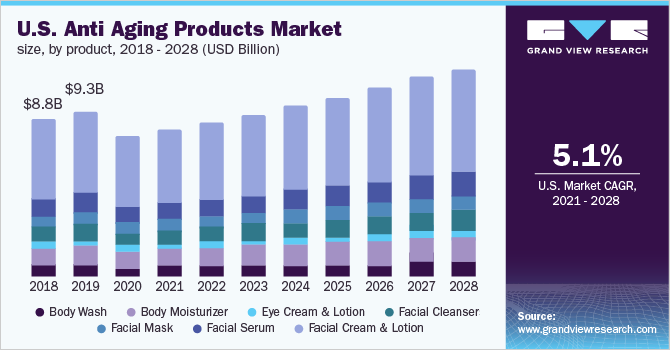Anti-Aging Products Industry Overview
The global anti-aging products market size was valued at USD 40.49 billion in 2020 and is expected to expand at a compound annual growth rate (CAGR) of 5.4% from 2021 to 2028. Rising awareness among consumers related to age-related skin problems such as fine lines, wrinkles, and dullness of skin, coupled with an increasing propensity to spend on products that help them to proclaim their skin youthfulness, is expected to drive the market demand throughout the forecast period.
The COVID-19 outbreak reduced the market demand for cosmetics, including anti-aging products, globally. Primarily, countries such as the U.S., India, Brazil, Russia, and the U.K., which are some of the most adversely affected, have witnessed a high decrease in sales. Many manufacturers in the market have been historically relying on China for finished products as well as raw materials used in the manufacturing of various types of skincare cosmetics, which have disrupted the production and distribution of these products.
Gather more insights about the market drivers, restraints, and growth of the Global Anti-Aging Products market
Although aging is a physiological change, extrinsic factors such as air pollution, alcohol consumption, and exposure to UV rays are known to have a detrimental effect on skin cell contribution to premature aging. Anti-aging creams and lotions play a vital role in an individual's life by assisting in the preservation of a youthful glow and moisturization. According to a survey by Real Self in 2020, 62% of Americans used anti-aging products as a part of their daily skincare routine.
China is one of the major countries contributing to the worldwide cosmetics and skincare market's growth in terms of consumption as well as production, including anti-aging, skin lightening, and sun care. According to the seventh population census in China in 2020, about 40.08% of the population is between 30 and 54 years. The presence of a large young population is expected to drive the demand for anti-aging products in the country.

The growing inclination towards plant-based alternatives has resulted in a recent shift in consumer preference for organic and natural products. In this regard, many brands are providing anti-aging products based on chemical-free ingredients. For instance, Alpyn Beauty, a manufacturer of skincare products, offers a chemical-free Plant Genuismelt moisturizer with bakuchiol that brightens skin and guards it against wrinkle and radical damage.
Moreover, numerous cross-over products have emerged under the natural beauty trend. These offer the dual functionality of makeup as well as wrinkle care to help people protect their natural skin. For instance, Lancôme, a part of the L’Oreal brand, offers a range of makeup and cosmetics that contain anti-aging genifique serum.
Browse through Grand View Research's Beauty & Personal Care Industry Research Reports
Skin Care Products Market - The global skin care products market size was valued at USD 130.50 billion in 2021 and is expected to expand at a compound annual growth rate (CAGR) of 4.6% from 2022 to 2030.
Skin Lightening Products Market - The global skin lightening products market size was valued at USD 9.96 billion in 2021 and is expected to expand at a compound annual growth rate (CAGR) of 5.5% from 2022 to 2030.
Anti-Aging Products Market Segmentation
Grand View Research has segmented the global anti aging products market on the basis of product, distribution channel, and region:
Anti-aging Products Outlook (Revenue, USD Million, 2016 - 2028)
- Body Wash
- Body Moisturizer
- Eye Cream & Lotion
- Facial Cleanser
- Facial Mask
- Facial Serum
- Facial Cream & Lotion
Anti-aging Products Distribution Channel Outlook (Revenue, USD Million, 2016 - 2028)
- Hypermarket & Supermarket
- Pharmacy & Drug Stores
- Specialty Store
- Online
- Others
Anti-aging Products Regional Outlook (Revenue, USD Million, 2016 - 2028)
- North America
- Europe
- Asia Pacific
- Central & South America
- Middle East & Africa
Market Share Insights:
October 2018: The Face Shop, a South Korea-based skincare manufacturer, retailer, and franchiser, launched a new product line Yehwadam, focusing on brightening and antiaging concerns.
Key Companies profiled:
Some prominent players in the global Anti-Aging Products market include
- Estée Lauder Inc.
- Procter & Gamble
- Beiersdorf Limited
- com & Age Sciences Inc.
- Shiseido
- Unilever
- L’Oreal Paris
- Revlon
- Oriflame Cosmetics
- Avon Products, Inc.
Order a free sample PDF of the Anti-Aging Products Market Intelligence Study, published by Grand View Research.


No comments:
Post a Comment